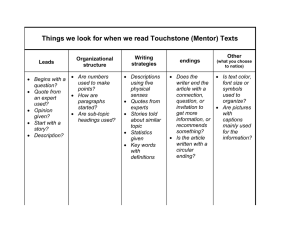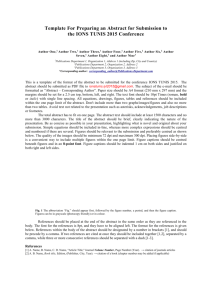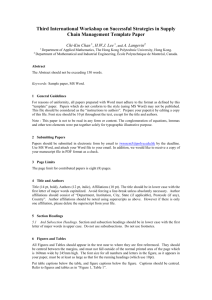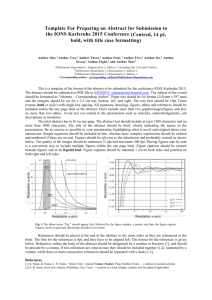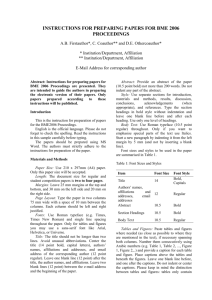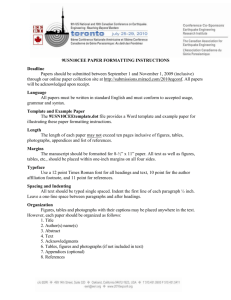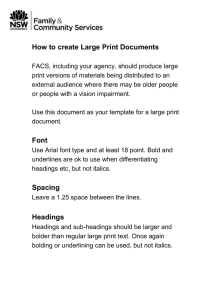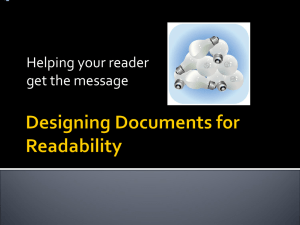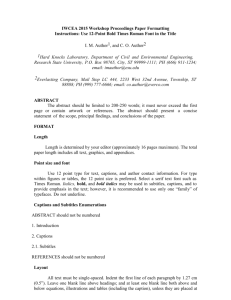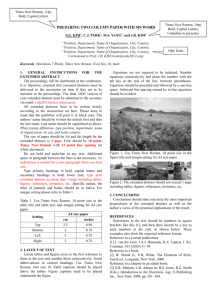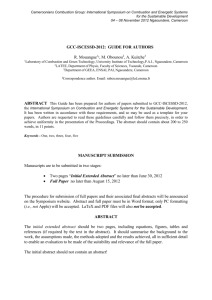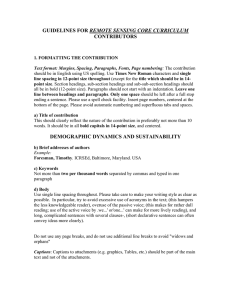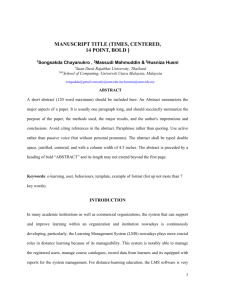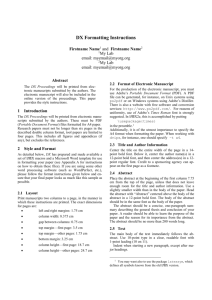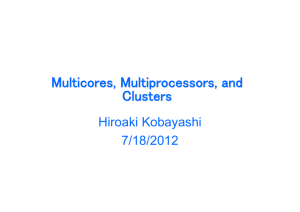Innovation and Supply Chain Management, Vol. 6, No.3, pp.001
advertisement
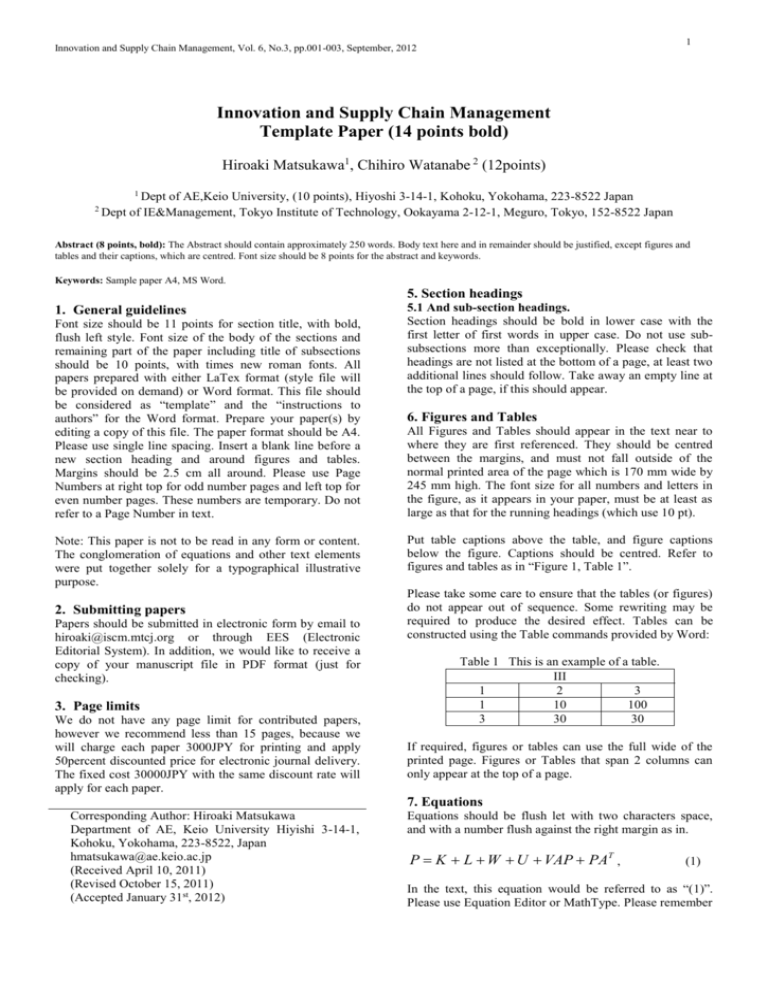
1 Innovation and Supply Chain Management, Vol. 6, No.3, pp.001-003, September, 2012 Innovation and Supply Chain Management Template Paper (14 points bold) Hiroaki Matsukawa1, Chihiro Watanabe 2 (12points) 1 2 Dept of AE,Keio University, (10 points), Hiyoshi 3-14-1, Kohoku, Yokohama, 223-8522 Japan Dept of IE&Management, Tokyo Institute of Technology, Ookayama 2-12-1, Meguro, Tokyo, 152-8522 Japan Abstract (8 points, bold): The Abstract should contain approximately 250 words. Body text here and in remainder should be justified, except figures and tables and their captions, which are centred. Font size should be 8 points for the abstract and keywords. Keywords: Sample paper A4, MS Word. 5. Section headings 1. General guidelines Font size should be 11 points for section title, with bold, flush left style. Font size of the body of the sections and remaining part of the paper including title of subsections should be 10 points, with times new roman fonts. All papers prepared with either LaTex format (style file will be provided on demand) or Word format. This file should be considered as “template” and the “instructions to authors” for the Word format. Prepare your paper(s) by editing a copy of this file. The paper format should be A4. Please use single line spacing. Insert a blank line before a new section heading and around figures and tables. Margins should be 2.5 cm all around. Please use Page Numbers at right top for odd number pages and left top for even number pages. These numbers are temporary. Do not refer to a Page Number in text. Note: This paper is not to be read in any form or content. The conglomeration of equations and other text elements were put together solely for a typographical illustrative purpose. 2. Submitting papers Papers should be submitted in electronic form by email to hiroaki@iscm.mtcj.org or through EES (Electronic Editorial System). In addition, we would like to receive a copy of your manuscript file in PDF format (just for checking). 3. Page limits We do not have any page limit for contributed papers, however we recommend less than 15 pages, because we will charge each paper 3000JPY for printing and apply 50percent discounted price for electronic journal delivery. The fixed cost 30000JPY with the same discount rate will apply for each paper. 5.1 And sub-section headings. Section headings should be bold in lower case with the first letter of first words in upper case. Do not use subsubsections more than exceptionally. Please check that headings are not listed at the bottom of a page, at least two additional lines should follow. Take away an empty line at the top of a page, if this should appear. 6. Figures and Tables All Figures and Tables should appear in the text near to where they are first referenced. They should be centred between the margins, and must not fall outside of the normal printed area of the page which is 170 mm wide by 245 mm high. The font size for all numbers and letters in the figure, as it appears in your paper, must be at least as large as that for the running headings (which use 10 pt). Put table captions above the table, and figure captions below the figure. Captions should be centred. Refer to figures and tables as in “Figure 1, Table 1”. Please take some care to ensure that the tables (or figures) do not appear out of sequence. Some rewriting may be required to produce the desired effect. Tables can be constructed using the Table commands provided by Word: Table 1 This is an example of a table. III 1 2 3 1 10 100 3 30 30 If required, figures or tables can use the full wide of the printed page. Figures or Tables that span 2 columns can only appear at the top of a page. 7. Equations Corresponding Author: Hiroaki Matsukawa Department of AE, Keio University Hiyishi 3-14-1, Kohoku, Yokohama, 223-8522, Japan hmatsukawa@ae.keio.ac.jp (Received April 10, 2011) (Revised October 15, 2011) (Accepted January 31st, 2012) Equations should be flush let with two characters space, and with a number flush against the right margin as in. P K L W U VAP PAT , (1) In the text, this equation would be referred to as “(1)”. Please use Equation Editor or MathType. Please remember Innovation and Supply Chain Management, Vol. 6, No.3, September, 2012 2 that equations are part of the running text, and should be ended with a full stop (period) if they finish the sentence, and with a comma, if a sub-sentence follows, and that the preceding text acknowledges the equation as part of the sentence (such as no full stop immediately preceding an equation). The equation number (1) thus follows on the same line that ends the equation. Each reference ends with a full stop (period). Appendix Appendices should be after the references. 7.5 5 2.5 0.5 1 1.5 2 2.5 3 -2.5 -5 -7.5 Figure 1. Import Meta file. 8. Format for References The references are listed as shown by the examples at the end of this paper and listed by the order of appearance in the body of paper. They may be referred to by the reference numbers. For example, Karp [1] and Magazine [2], or Researches [1]-[3]. 9. Abbreviations When abbreviating words, use the full stop (period) to replace the missing characters, and not after an abbreviation where the last character is the original. Examples: “Dr” (not “Dr.”), “Mr” (not “Mr.”), “Vol.” (not “Vol”), “No.” (not “No”). 10. Conclusions You should include a brief conclusion section which summarises the results of your paper. 11. Acknowledgements (Optional) Any acknowledgements should be immediately before the references. 12. References All publications cited in the text should be presented in a list of references. All publications in this list should have a reference in the text. References should be in the following style: [1] Karp, R.M., 1992. Reducibility among combinatorial problems. In: Miller, R.E., Thatcher, J.W., (Eds.). Complexity of computer computations. New York: Plenum Press, 85-103. [2] Magazine, M., 1969. Optimal policies for queuing systems with periodic review. Dissertation, University of Florida, USA. [3] Tu, C.-C., Cheng, H., 1998. Spectral methods for graph bisection problems. Computers and Operations Research, 25 (7-8), 519-30. 2
